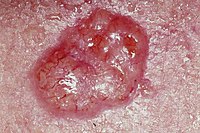
Effects of adiponectin on random pattern skin flap survival in rats.
Sign Up to like & getrecommendations! Published in 2019 at "International immunopharmacology"
DOI: 10.1016/j.intimp.2019.105875
Abstract: BACKGROUND Random flaps are commonly used to repair wounds and improve the clinical appearance. However, flap necrosis is frequently encountered in the clinical setting. Adiponectin is a biologically active endogenous polypeptide secreted by adipocytes that… read more here.
Keywords: skin flap; group; flap survival; effects adiponectin ... See more keywords

Sumatriptan Increases Skin Flap Survival through Activation of 5-Hydroxytryptamine 1b/1d Receptors in Rats: The Mediating Role of the Nitric Oxide Pathway.
Sign Up to like & getrecommendations! Published in 2019 at "Plastic and reconstructive surgery"
DOI: 10.1097/prs.0000000000005740
Abstract: BACKGROUND Random pattern skin flaps are applicable for reconstructing any defect in plastic surgery. However, they are difficult to apply because of necrosis. Sumatriptan, a selective 5-hydroxytryptamine 1b/1d agonist, is routinely used to offset acute… read more here.
Keywords: role; skin flap; nitric oxide; flap survival ... See more keywords

Effects of catalpol from Rehmannia glutinosa extract on skin flaps.
Sign Up to like & getrecommendations! Published in 2023 at "Plastic and reconstructive surgery"
DOI: 10.1097/prs.0000000000010650
Abstract: BACKGROUND Flaps are commonly used for repairing tissues and wounds in surgery. However, various factors can cause postoperative necrosis in these flaps. Catalpol is a bioactive component in extracts from Rehmannia glutinosa, which has pharmacological… read more here.
Keywords: catalpol rehmannia; effects catalpol; flap survival; rehmannia glutinosa ... See more keywords

Human and Autologous Adipose-derived Stromal Cells Increase Flap Survival in Rats Independently of Host Immune Response
Sign Up to like & getrecommendations! Published in 2018 at "Annals of Plastic Surgery"
DOI: 10.1097/sap.0000000000001184
Abstract: Introduction There is a rising interest in adipose-derived stromal cells for clinical use; however, it is unknown whether freshly isolated stromal cells (SVF) or culture-expanded cells (ASCs) are more efficacious. We therefore aimed to compare… read more here.
Keywords: host immune; flap survival; stromal cells; svf ... See more keywords

Identification of Unequal Flow-Carrying Capabilities of Choke Vessels in Rat Abdominal Flaps
Sign Up to like & getrecommendations! Published in 2022 at "Annals of Plastic Surgery"
DOI: 10.1097/sap.0000000000003300
Abstract: Background Although the angiosome concept is a well-accepted theory, unexpected necrosis suggests that other factors can influence the flap survival. Our study uses the rat model to explore the flow capacity of the choke vessels… read more here.
Keywords: carrying capabilities; flow; flap survival; choke vessels ... See more keywords

Roxadustat promotes hypoxia-inducible factor-1α/vascular endothelial growth factor signalling to enhance random skin flap survival in rats.
Sign Up to like & getrecommendations! Published in 2023 at "International wound journal"
DOI: 10.1111/iwj.14235
Abstract: Random skin flaps have limited clinical application as a broad surgical reconstruction treatment because of distal necrosis. The prolyl hydroxylase domain-containing protein inhibitor roxadustat (RXD) enhances angiogenesis and reduces oxidative stress and inflammation. This study… read more here.
Keywords: factor; flap survival; group; random skin ... See more keywords

Bioactive nanoparticle-based formulations increase survival area of perforator flaps in a rat model
Sign Up to like & getrecommendations! Published in 2018 at "PLoS ONE"
DOI: 10.1371/journal.pone.0207802
Abstract: Background Distal flap necrosis is a frequent complication of perforator flaps. Advances in nanotechnology offer exciting new therapeutic approaches. Anti-inflammatory and neo-angiogenic properties of certain metal oxides within the nanoparticles, including bioglass and ceria, may… read more here.
Keywords: flap survival; perforator; nanoparticle; formulations increase ... See more keywords

Butylphthalide Inhibits Autophagy and Promotes Multiterritory Perforator Flap Survival
Sign Up to like & getrecommendations! Published in 2020 at "Frontiers in Pharmacology"
DOI: 10.3389/fphar.2020.612932
Abstract: Multiterritory perforator flap is an important plastic surgery technique, yet its efficacy can be limited by partial necrosis at the choke Ⅱ zone. Butylphthalide (NBP) has been used for many diseases but has not been… read more here.
Keywords: perforator flap; perforator; flap survival; multiterritory perforator ... See more keywords

Rivastigmine Regulates the HIF-1α/VEGF Signaling Pathway to Induce Angiogenesis and Improves the Survival of Random Flaps in Rats
Sign Up to like & getrecommendations! Published in 2022 at "Frontiers in Pharmacology"
DOI: 10.3389/fphar.2021.818907
Abstract: Random skin flaps are frequently used to repair skin damage. However, the ischemic and hypoxic necrosis limits their wider application. Rivastigmine, a carbamate cholinesterase inhibitor (ChEI), has also been shown to reduce ischemia–reperfusion injury (IRI)… read more here.
Keywords: random; vegf; group; flap survival ... See more keywords